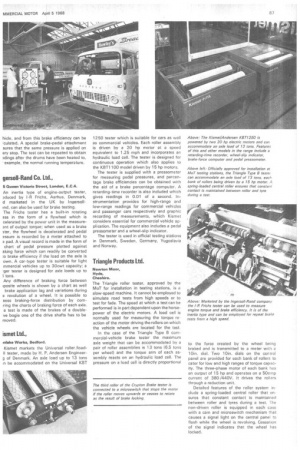Triangle Products Ltd.
Page 89

If you've noticed an error in this article please click here to report it so we can fix it.
Newton Moor, Hyde, Cheshire.
The Triangle roller tester, approved by the MoT for installation in testing stations, is a slow-speed machine. It cannot be employed to simulate road tests from high speeds or to test for fade. The speed at which a test can be performed is in part dependent upon the horsepower of the electric motors. A load cell is normally used for measuring the torque reaction of the motor driving the rollers on which the vehicle wheels are located for the test.
In the case of the Triangle Type B commercial-vehicle brake tester the maximum axle weight that can be accommodated by a pair of roller assemblies is 13 tons 16.5 tons per wheel) and the torque arm of each assembly reacts on an hydraulic load cell. The pressure on a load cell is directly proportional
to the force created by the wheel being braked and is transmitted to a meter with a 10in, dial. Two 10in, dials on the control panel are provided for each bank of rollers to cater for low and high ranges of torque capacity. The three-phase motor of each bank has an output of 15 hp and operates on a 50amp current of 380 /440V. It drives the rollers through a reduction unit.
Detailed features of the roller system include a spring-loaded central roller that ensures that constant contact is maintained between roller and tyres during a test. The non-driven roller is equipped in each case with a cam and microswitch mechanism that causes a signal light on the central panel to flash while the wheel is revolving. Cessation of the signal indicates that the wheel has locked.




























































































































































